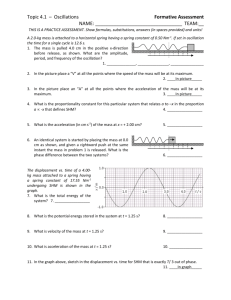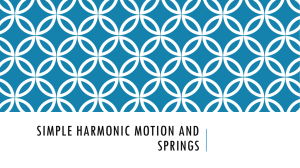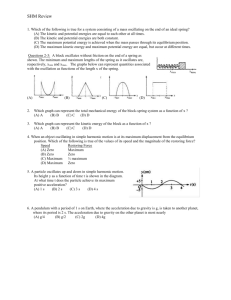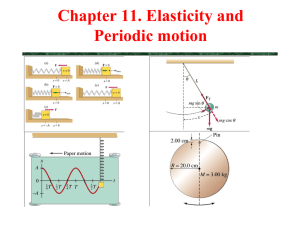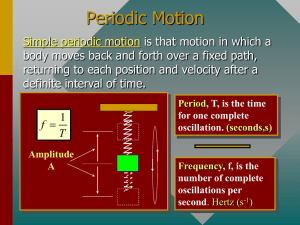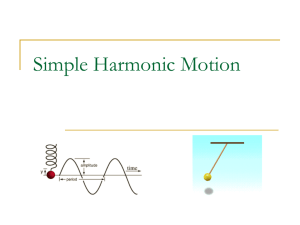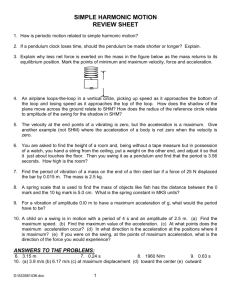Oscillations 1
advertisement
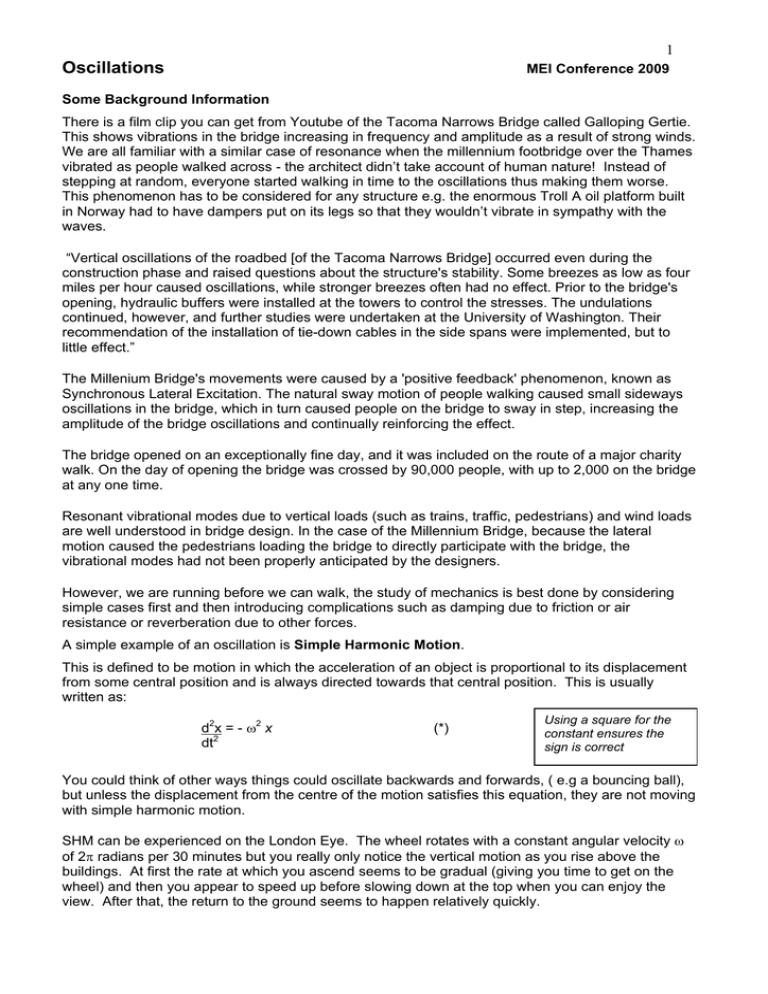
1 Oscillations MEI Conference 2009 Some Background Information There is a film clip you can get from Youtube of the Tacoma Narrows Bridge called Galloping Gertie. This shows vibrations in the bridge increasing in frequency and amplitude as a result of strong winds. We are all familiar with a similar case of resonance when the millennium footbridge over the Thames vibrated as people walked across - the architect didn’t take account of human nature! Instead of stepping at random, everyone started walking in time to the oscillations thus making them worse. This phenomenon has to be considered for any structure e.g. the enormous Troll A oil platform built in Norway had to have dampers put on its legs so that they wouldn’t vibrate in sympathy with the waves. “Vertical oscillations of the roadbed [of the Tacoma Narrows Bridge] occurred even during the construction phase and raised questions about the structure's stability. Some breezes as low as four miles per hour caused oscillations, while stronger breezes often had no effect. Prior to the bridge's opening, hydraulic buffers were installed at the towers to control the stresses. The undulations continued, however, and further studies were undertaken at the University of Washington. Their recommendation of the installation of tie-down cables in the side spans were implemented, but to little effect.” The Millenium Bridge's movements were caused by a 'positive feedback' phenomenon, known as Synchronous Lateral Excitation. The natural sway motion of people walking caused small sideways oscillations in the bridge, which in turn caused people on the bridge to sway in step, increasing the amplitude of the bridge oscillations and continually reinforcing the effect. The bridge opened on an exceptionally fine day, and it was included on the route of a major charity walk. On the day of opening the bridge was crossed by 90,000 people, with up to 2,000 on the bridge at any one time. Resonant vibrational modes due to vertical loads (such as trains, traffic, pedestrians) and wind loads are well understood in bridge design. In the case of the Millennium Bridge, because the lateral motion caused the pedestrians loading the bridge to directly participate with the bridge, the vibrational modes had not been properly anticipated by the designers. However, we are running before we can walk, the study of mechanics is best done by considering simple cases first and then introducing complications such as damping due to friction or air resistance or reverberation due to other forces. A simple example of an oscillation is Simple Harmonic Motion. This is defined to be motion in which the acceleration of an object is proportional to its displacement from some central position and is always directed towards that central position. This is usually written as: d2x = - ω2 x dt2 (*) Using a square for the constant ensures the sign is correct You could think of other ways things could oscillate backwards and forwards, ( e.g a bouncing ball), but unless the displacement from the centre of the motion satisfies this equation, they are not moving with simple harmonic motion. SHM can be experienced on the London Eye. The wheel rotates with a constant angular velocity ω of 2π radians per 30 minutes but you really only notice the vertical motion as you rise above the buildings. At first the rate at which you ascend seems to be gradual (giving you time to get on the wheel) and then you appear to speed up before slowing down at the top when you can enjoy the view. After that, the return to the ground seems to happen relatively quickly. 2 Your height H above the ground at time t is given by H = R - Rcosωt Alternatively y = Rcosωt where y is the vertical distance below the centre of the wheel, R the radius (67.5m) and ω the angular velocity (2π/1800 rad s-1) You can differentiate the second equation twice to obtain d2y = - ω Rcosωt = - ω y dt2 2 2 demonstrating SHM But notice that H does not satisfy the equation for SHM because H is not the displacement from the centre of the oscillation. The horizontal displacement from O also satisfies the SHM equation, but you tend notice this motion less when you are on the wheel. This example illustrates why we use ω for the constant of proportionality, but this projection of circular motion is the only case where ω actually represents an angular velocity. It certainly does not when considering other mechanical systems such as springs and pendulums (see below). 2 http://www.box.net/shared/3akslm4pog http://en.wikipedia.org/wiki/Tacoma_Narrows_Bridge http://en.wikipedia.org/wiki/Troll_A_platform http://en.wikipedia.org/wiki/London_Eye EQUATIONS FOR SIMPLE HARMONIC MOTION You can approach the study of SHM from two possible directions (the kinematics or the dynamics). (1) Look for functions which satisfy the equation (*). Either it can be integrated directly (see Mechanics3 pp 187-8 ) giving sine and cosine functions or you could assume the displacement follows a sine or cosine rule and work from there. You should be aware, however, that the latter approach does not show that these are the only possible functions. Only direct integration does that. (2) Alternatively, you could start with a mechanical system (e.g. a weight on the end of an elastic string, or a bob on a pendulum).and then use Newton’s second law to model the motion. (1) Working from the Trigonometrical Functions Before Starting Remember: angle 0 π 2 π 3π 2 2π sine 0 1 0 -1 0 cosine 1 0 -1 0 1 sin2ωt + cos2ωt = 1, the derivative of sinωt is ωcosωt, the derivative of cosωt is - ωsinωt 3 We are looking for an equation connecting the displacement of an object with time and there are two quantities which are important: They are the amplitude and the frequency - how big are the oscillations and how fast? The first oscillation is shallower than the second, it has smaller amplitude and it is also less frequent. The second oscillates twice as frequently as the first and moves further from its mean position. The period is the time taken to return to the initial conditions. In each case, the amplitude and frequency are constant and the motion can be represented by a sine curve or a cosine curve, or even a combination of the two depending on the initial situation when t is 0. Changing the initial conditions is equivalent to moving the origin (i.e. the vertical axis). When the amplitude is a and the displacement x is 0 when t = 0, the equation for the displacement can be written as : x = asinωt The velocity and acceleration can then be found by differentiating with respect to t. v = aωcosωt acc = - aω2sinωt But here we meet a problem because we can’t use a for amplitude and acceleration. The amplitude is constant but the acceleration varies, so it is useful to bring in Newton’s notation and use velocity = dx = dt and acceleration = d2x = dt2 So the three equations which describe the motion can be written as: x = asinωt = aωcosωt = - aω2sinωt (1) (2) (3) You can see from these that x varies between -a and +a and varies between - aω and +aω The time (T) to return to the initial conditions is when ωT = 2π. i.e. T = 2π ω (4) T is called the period of the oscillations and is related to the frequency f by f = 1/T. Units for f are oscillations per second and for T seconds per oscillation Also (1) and (2) give (ωx) + 2 so Also, from equations (1) and (3) 2 =aω 2 = a2(ω2- x2) 2 4 2 = - ω2x sin2ωt + cos2ωt = 1 (5) (6) which is the equation for SHM These are basic equations for the SHM giving displacement, velocity and acceleration in terms of time, the period of the motion and also the velocity and acceleration in terms of the displacement. Equation (6) shows that the acceleration is proportional to the displacement, but always directed towards the centre of the oscillation. Whenever x is positive, is negative and vice versa. The maximum speed is aω and the maximum acceleration is aω2 If you start with the cosine function, the first three equations become: x = acosωt = - aωsinωt = - aω2cosωt (7) (8) (9) Equations (4), (5) and (6) are unchanged. If you want to start measuring time from a different point in the motion, the first equation could be written as Compare x = asin(ωt + ε) or x = Asinωt + Bcosωt the R-form acosε = A , asinε = B and a2 = A2 + B2 with The next two equations follow as before and the last three equations will still be the same. There is a diagram in the Mechanics 3 book showing how the various quantities change as the oscillations take place. (page 86) (2) Working from the Physical Situation Two situations which give rise to SHM are: (a) a bob attached to an elastic string or spring (b) a bob oscillating as a pendulum Before starting remember: Using stresses the fact that the acceleration is variable Newton’s second law is F = m (a) Hooke’s law for an elastic string or spring is T = k x extension or T = λ x extension l Where k is the stiffness, λ, the modulus of elasticity and l the natural length. Now T is the tension in the string not the period. A compression in a spring occurs when the extension is negative. For this situation a good clear diagram is essential mainly because it is easy to confuse the extension of the string with the displacement from the centre of the oscillation. It is important to remember that the equilibrium position when = 0 is the centre of any SHM. EXAMPLE A bob of mass m kg hangs in equilibrium on the end of a light elastic string of natural length l and stiffness k. It is displaced from this position. Show that it performs SHM and write down the period of the motion. 5 SOLUTION The diagram shows the essential features: The natural length l of the string (ON) The extension e in the equilibrium position, (E) The extra extension x when the bob is in a general position below this. The forces acting on the bob in this general position. The acceleration . The positive direction is downwards. Now the equation of motion can be written down when the bob is in equilibrium: T = mg so and by Hooke’s law T = ke ke = mg In the general position: Notice that a string might become slack if the amplitude of the motion is > e. Then the SHM breaks down. mg - T = m and by Hooke’s law T = k(e + x) mg - ke - kx = m Hence k SHM will not break down for a spring which can be compressed. = - k x which is the SHM equation with ω2= m m The period of the motion is The same symbol (T) is used for Tension and period, take care not to confuse them (b) For a pendulum we’ll need the tangential acceleration of a particle moving in a circle which is l when the radius is the length l of the pendulum. EXAMPLE A bob of mass m kg is attached to the end of an inelastic string of length l and suspended from a point O. The bob is pulled aside and let go. Show that, providing the angle between the string and the vertical is sufficiently small, the bob will perform SHM. Write down the period of the oscillations. SOLUTION Newton’s second law in the tangential direction gives: mgsinθ = -m l so = - g sinθ l This is not the standard equation for SHM because the variable replacing x is θ and this shows proportional to sinθ rather than θ. However, if θ is less than about 0.2 radians, sinθ ~ θ so the motion is approximately SHM with displacement θ. =-gθ l In this case ω2 is so the period is 2π 6 Notice that ω is NOT the angular velocity If the maximum value of θ is α: 2 of the pendulum. = ω ( α 2 - θ 2) 2 7 EXAMPLE The London Eye has a height of 135m and takes 30 minutes for one rotation. For how long are you more than 100m above ground level when in the Eye? (Ignore your own height) SOLUTION You can choose which equations you use in this question, but take care to specify your variables carefully. When the height above the centre is xm and time is measured from x = Rsinωt x = 0, the appropriate equation is: Your height is greater than 100m when x+ R > 100 x > 32.5 sinωt > 32.5/67.5 sinωt > 0.48148 0.502 < ωt < π- 0.502 sin 0.502 = 0.48148 so Time can be measured in minutes as there are no forces involved and no need to use g = 9.8 ms-2 So 2π = 30, and ω ω = 2π 30 So you are above 100m high when 0.502 < 2π t < π- 0.502 30 2.40 < t < 12.60 You are higher than 100m for about 10.2 minutes - i.e. about a third of the time you are aboard. TACKLING EXAM QUESTIONS • take care when defining variables and ensure that you know what they all represent; • take particular care with elastic strings not to confuse extension with displacement from the equilibrium position; • draw good diagrams showing all constants and variables clearly; • choose the equations you use carefully. • To demonstrate SHM you need which integrates to give • • 2 = - ω2x (1) = a2(ω2- x2) (2) and x = asin(ωt + ε) (3) or x = asinωt (4) or x = acosωt (5) or x = Asinωt + Bcosωt (6) differentiate (3) to (6) to obtain corresponding expressions for and a2 = A2 + B2 in terms of t. e.g.for (3): = aωcos(ωt + ε) (7) Max speed = aω and = - aω sin(ωt + ε) (8) Max acc. = aω 2 Period = 2π 2 (9) ω Pat Bryden June 2009 8 June 2004 Pat Bryden June 2009 9 Pat Bryden June 2009 10 January 2003 Pat Bryden June 2009 11 Pat Bryden June 2009 12 Pat Bryden June 2009 13 Pat Bryden June 2009
